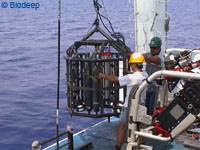New bacteria found 3.3km below Mediterranean
Researchers from the EU-funded BIODEEP project have published their findings in the journal Nature, revealing a diverse ecosystem in hostile undersea 'lakes', below the Mediterranean Sea. A long way below the swimmers, ships and even the fish in the deep-blue of the Mediterranean hide super high-density 'lakes' of high-salinity water three to four kilometres below the surface. These lakes have ten times the salt of the sea-water above and are under 400 atmospheres of pressure. This has kept these lakes separate from the rest of the sea for a long time. The high salinity brine and the sea water do not mix, and are separated by an interface approximately 2.5m thick. Professor Timmis of the German Research Centre for Biotechnology (GBF) is a member of the team that explored the brine lakes. He explains: 'Despite the fact that such environments exist on our planet, we know so little about them that their exploration is as exciting as interplanetary missions. The big question was: do they contain new forms of life?' The team sent a robotic submarine down into these lakes in order to sample the waters and search for living things in this inhospitable climate. They found considerable anaerobic salt and pressure-tolerant bacteria at a depth of 3.3km off the northern coast of Africa in an area known as the Bannock Basin. These bacteria could produce chemicals or enzymes which may be useful in the chemical, cosmetic, food, pharmaceutical or biotechnology industries The team's paper specifically looks at bacteria living at the cusp between the anaerobic conditions of the supersaline water and the fresher sea water above. This interface seemed to trap both decaying matter sinking to the bottom, and gases such as methane floating to the top. The interface contained approximately ten million microbial cells per litre. Both the underlying brine and the deep seawater above contained one per cent of the bacteria present in the interface. Although bacteria had been observed in these super-saline basins before, the team were able to identify four new divisions of bacteria: Mediterranean Sea Brine Lake (MSBL) 3-6. The team also found that specific bacteria lived in specific areas of salinity in the interface, with different bacteria living just centimetres apart. 'Our current investigations indicate that phylogenetic [evolutionary related] diversity reflects functional diversity, that is: new organisms have new activities and make new bioproducts with potential for medical and chemical applications,' says Professor Timmis. 'The discrete stratified habitats of the brine lake interfaces constitute exceptional conditions in which novel organisms have evolved. Systematic exploration of these and other extreme environments, and characterization of the biological properties of the new organisms found, will undoubtedly lead to important discoveries about life processes and interesting new biotechnological applications.'
Countries
Germany



